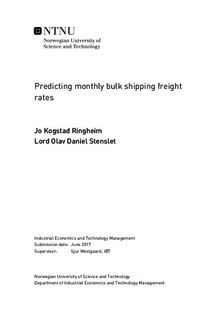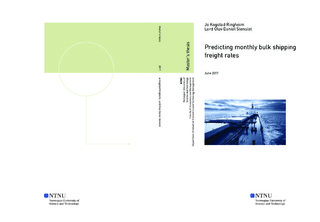| dc.description.abstract | The main purpose of this thesis is to provide best possible one-month forecasts of both dry bulk (Baltic Dry Index) and tanker (Baltic Dirty Tanker Index) freight rates. In order to find superior leading rate predictors, We apply a general-to-specific methodology as outlined by Campos et al. [2005], where a comprehensive, yet well-justified set of variables are collected. In total, 44 dry bulk variables and 37 tanker time series are gathered with monthly resolution from Jan-2000 to Jun-2016, motivated by previous findings in the literature and common perceptions in the financial markets. The result is a total amount of 264 and 222 potential explanatory variables, as a lead-lag relationship up to six months is taken into account. The large amount of variables are reduced to a subset of predictors through a stepwise regression. The forecasts are calibrated by 150 observations from Jul-2000 to Dec-2012, while the remaining 42 observations constitute the out-of-sample window, where they are compared with relevant univariate benchmarks. We find that i) The single most significant dry bulk predictor is the dry bulk equity index. This finding is interesting, as it implies that shipping stocks tend to move prior to freight rates. It is also in correspondence with the recent findings of dings of Westgaard et al.[2017]. The single most significant tanker predictor is the oil price, which is consistent with the findings of of Poulakidas and Joutz [2009]. ii) The best out-of-sample result in terms of predictive accuracy is achieved by a univariate seasonal model, for both dry bulk and tanker rates. The forecasts are unable to beat this benchmark in terms of predictive accuracy, but two tanker models are better in terms of correlation. iii) Incorporating effects of deterministic seasonality improve the correlation of all forecasts and simultaneously result in equal or better predicting accuracy. Moreover, as the best model in terms accuracy is the univariate seasonal model, the results are in accordance with the conclusions of Kavussanos and Alizadeh-M [2001,2002], that bulk freight rates exhibit significant deterministic seasonality. Our findings have implications for shipping participants' operational decision making, as acting upon the model with best predictive accuracy may improve their utility. | |

